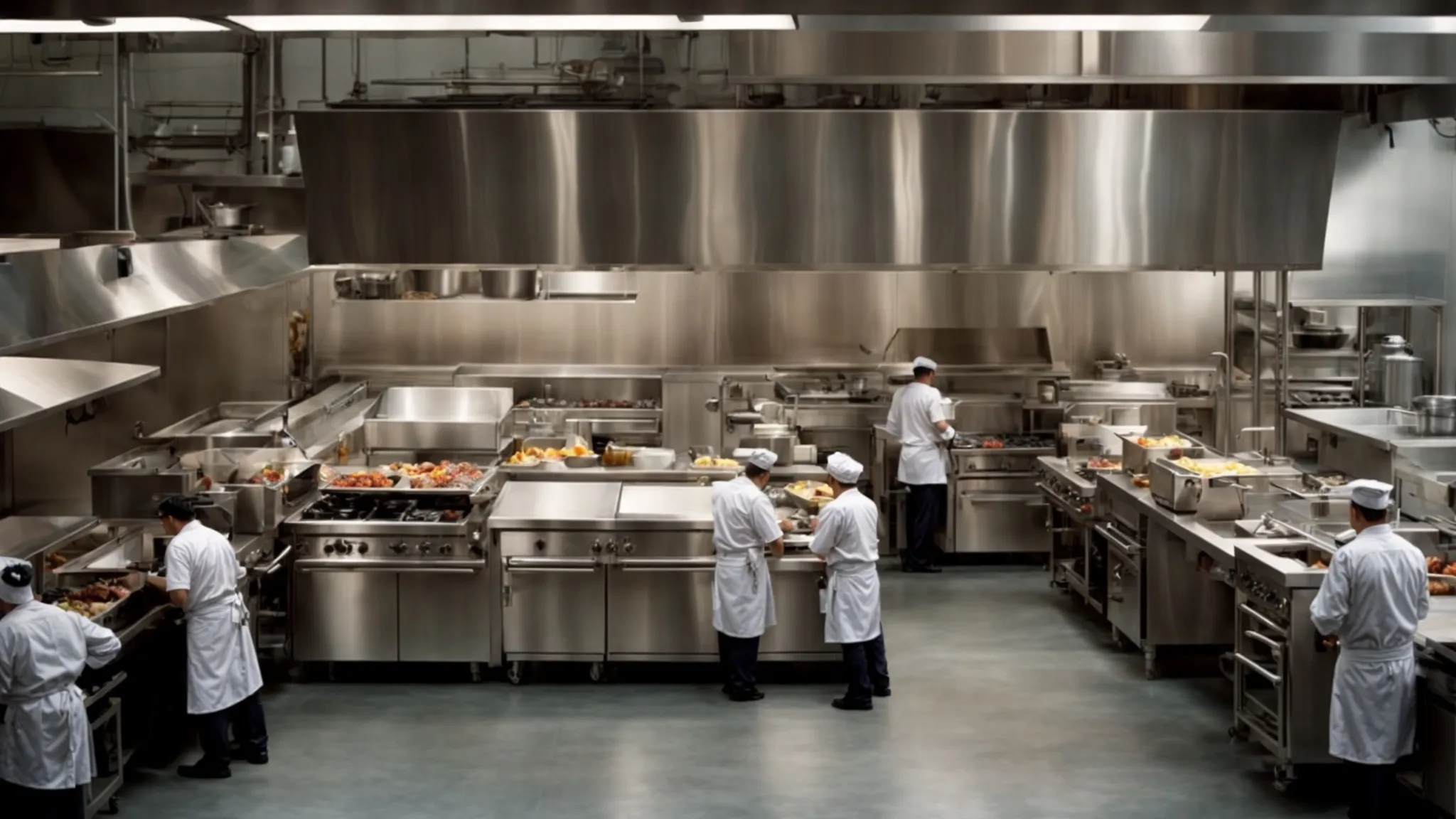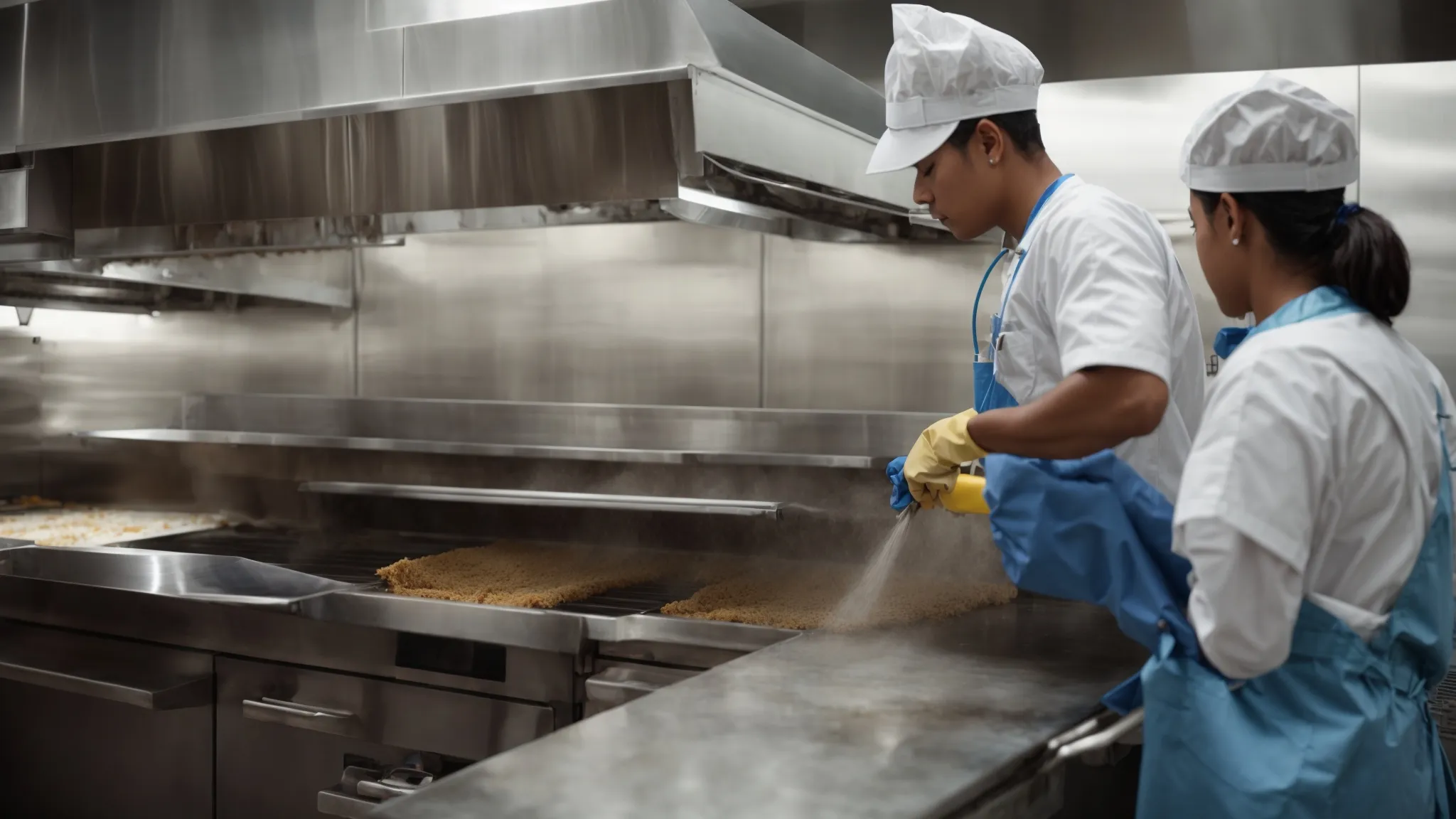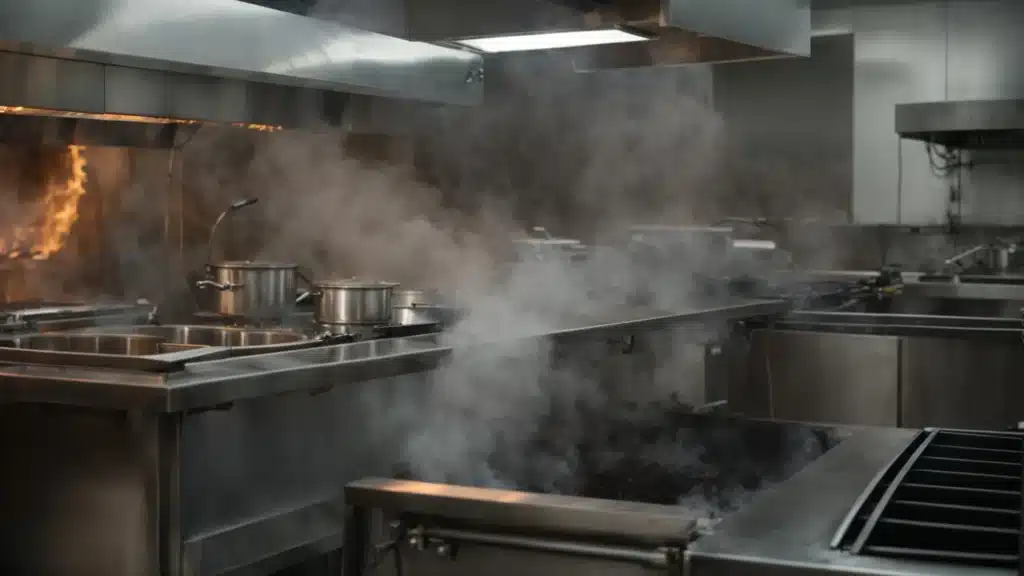Exhaust Cleaning: Key to Minimizing Fire Risks in Commercial Areas
In the bustling heart of every commercial kitchen lies the unsung hero that, if neglected, can turn into a formidable adversary – the exhaust system.
Like arteries in the body, these channels, crusted with grease and contaminants, can clog, straining not just airflow but also safety.
Regular exhaust maintenance emerges not just as a beacon of operational efficiency but as a crucial shield against the spectre of kitchen fires.
Through a meticulous dance of cleaning and upkeep, businesses stand to illuminate their commitment to safety, health, and the well-being of both staff and patrons.
Keep reading to discover how an immaculate exhaust system transcends mere fire prevention, weaving into the fabric of a thriving, safe, and efficient commercial space.
Check out this cleaning video showing our team’s abilities for Hood and Kitchen Exhaust Cleaning.
Reducing Fire Hazards in Commercial Establishments Importance of Exhaust Cleaning
Key Takeaways
- Regular Maintenance and Cleaning of Exhaust Systems Are Critical for Fire Risk Reduction and Kitchen Safety
- Utilizing Professional Cleaning Services Can Address Complex Exhaust System Issues and Ensure Compliance With Fire Safety Regulations
- The Selection of Eco-Friendly Cleaning Agents Supports Environmental Stewardship While Effectively Combating Grease and Contaminants
- Comprehensive Staff Training on Fire Safety and Exhaust Management Enhances the Overall Safety Culture Within Commercial Kitchens
- A Clean Exhaust System Improves Indoor Air Quality, Contributing to a Healthier Workplace for Employees and a Better Dining Experience for Patrons
Understanding the Importance of Regular Exhaust Maintenance

At the heart of fostering a safe cooking environment, lies the intricate web of exhaust systems, woven meticulously into the fabric of commercial kitchens.
It’s a realm where grease and heat intertwine, casting a shadow over safety with each meal prepared.
The vital importance of regular exhaust maintenance becomes apparent, serving as a guardian against the ever-looming threat of fires.
Through embarking on a journey of identifying potential hazards hidden within the ducts, chimneys, and fans, establishments take the first step towards minimizing risks.
Coupled with this, the role of maintenance, not just as a routine check but as a strategy for fire risk reduction, emerges as a beacon of assurance for commercial areas.
It’s an orchestrated effort to ensure the heart of the kitchen beats safely, underscoring the critical nature of unwavering vigilance and commitment to cleanliness and safety standards.
Identifying Potential Hazards in Exhaust Systems
Peering into the labyrinth of commercial kitchen exhaust systems reveals a landscape ripe for potential hazards. Accumulations of grease, a seemingly innocuous byproduct of cooking, herald as one of the chief villains: silently lurking in ducts and hoods, it awaits the slightest spark to ignite disaster.
| Hazard | Location | Implication |
|---|---|---|
| Grease Accumulation | Ducts, Hoods | Fire Risk |
| Blocked Air Filters | Exhaust Fans | Reduced Airflow, Overheating |
| Worn-out Grease Filters | Vent Hoods | Increased Contamination and Fire Hazard |
| Improper Duct Installation | Exhaust Systems | Leakage, Inefficient Venting |
But the perils do not end with grease alone. Impaired airflow due to clogged air filters transforms an exhaust system into a breathing-challenged behemoth, struggling to expel the hot, contaminated air: a condition that, left unchecked, further primes the kitchen environment for incidents.
The Role of Maintenance in Fire Risk Reduction
Maintenance, when executed with precision and forethought, acts as the linchpin in the machinery of fire risk reduction. By cleansing the veins of the kitchen’s heart – the exhaust systems – of grease and blockages, it breathes life into the safety measures, ensuring they stand robust against the whispers of danger. Through this choreographed diligence, not only is the risk of fire significantly reduced, but the longevity of the kitchen’s apparatus is also fortified, safeguarding the dreams and investments of countless individuals.
| Maintenance Action | Beneficial Outcome | Preventive Impact |
|---|---|---|
| Regular Cleaning of Ducts and Fans | Reduced Grease Accumulation | Lower Fire Risk |
| Replacement of Worn-Out Filters | Improved Airflow | Prevented Overheating |
| Inspection and Correction of Duct Installation | Efficient Venting, No Leakage | Enhanced Equipment Performance |
The deft hand of regular maintenance extends beyond preventing disasters; it is the harbringer of peace of mind for both proprietors and patrons alike. In intertwining the threads of thorough inspections and immediate rectifications, establishments not only adhere to the stringent standards set forth by health and safety regulations but also voyage towards creating a sanctuary where the craft of culinary delight flourishes, unburdened by the specter of risks.
Grasping the necessity of routine exhaust upkeep paves the pathway to a revelation. Now, let us embark on an adventure through the meticulous steps of a complete exhaust cleaning journey.
Steps for a Comprehensive Exhaust Cleaning Process

Embarking on the quest for a fire-resistant kitchen begins with meticulous exhaust cleaning—a task that, while daunting, is indispensable for the safety and efficiency of commercial establishments.
The path to minimizing fire risks encompasses a series of crucial steps, each designed to ensure that every component of the exhaust system is free from grease, debris, and any obstruction that could spell disaster.
It starts with the careful preparation of your space and equipment, setting the stage for a process that leaves no stone unturned.
This journey then unfolds through a detailed walkthrough of the cleaning procedure, ensuring that from the greasiest duct to the tiniest ventilator, cleanliness prevails triumphantly over the risks of fire hazards.
This comprehensive approach not only adheres to regulatory standards but also shields establishments from the catastrophic consequences of neglect.
Preparing Your Space and Equipment for Cleaning
In the symphony of safety that commercial kitchens aim to orchestrate, the preliminary measure of preparing the space and equipment for cleaning strikes as the opening note. It is a pivotal act where the kitchen morphs into a blank canvas, liberated from the clutches of ongoing operations to ensure an unobstructed, thorough cleanup.
Securing all sensitive kitchen assets, from the delicate whisper of a ventilator to the robust stance of an oven, under the protective veil of covers, marks the genesis of a meticulous exhaust cleaning process. It’s a strategy that not only shields these vital components from potential damage but also paves the way for a cleaning expedition free from hindrances, ensuring every nook and cranny is addressed.
Detailed Walkthrough of the Cleaning Procedure
The journey to a pristine and safe kitchen embarks with an initial assessment, where professionals from Ontario Hood Cleaning identify and mark zones in the ventilation system fraught with grease and debris. This phase enables a targeted approach, ensuring that each segment of the ductwork receives the detailed attention it demands, employing tools and solutions that resonate with the stubbornness of accumulated grime.
Following the preparation, a symphony of scrubbing, degreasing, and rinsing unfolds, where trained technicians meticulously navigate through every conduit, chimney, and fan. Utilizing eco-friendly detergents, potent degreasers, and sophisticated equipment, such as high-pressure washers, they dissolve the residues of cooking battles past, restoring the exhaust system to a state of cleanliness where airflow is unimpeded and the risk of fire dramatically minimized.
Now, let’s shift gears and arm ourselves with the weapons of cleanliness. The selection of the right tools and chemicals can turn this battle against grime into a triumph.
Selecting the Right Tools and Chemicals for Exhaust Cleaning

Embarking upon the quest for immaculate exhaust systems demands a judicious selection of tools and agents, a process that not only defines efficiency but also underscores an establishment’s commitment to environmental stewardship and safety.
Understanding the critical role of these elements, the ensuing discourse sheds light on an array of indispensable cleaning instruments suited for banishing grease and debris.
Concurrently, it emphasizes the imperative of opting for cleaning agents that pledge potency against grime while embracing the ethos of eco-friendliness.
This approach ensures the seamless marriage of remarkable cleaning outcomes with minimal ecological footprint, heralding a new chapter in the saga of kitchen exhaust maintenance.
An Overview of Essential Cleaning Tools
Embarking on the journey towards a pristine kitchen exhaust system begins with the arsenal of tools at one’s disposal: a testament to the pivotal role they play in ensuring safety and cleanliness. High-pressure washers emerge as stalwarts in this battle, wielding the power to cut through layers of grime and grease with precision, rendering the exhaust pathways clean and clear.
| Tool | Usage | Benefit |
|---|---|---|
| High-pressure Washer | Removing grease and debris | Deep cleans, reducing fire risks |
| Vacuum System | Suctioning loose contaminants | Prevents dispersal, maintains cleanliness |
| Scrub Brushes and Degreasing Agents | Manual cleaning and chemical treatment | Ensures thorough removal of stubborn residues |
Equally crucial in this endeavor are the seemingly simple yet profoundly effective scrub brushes. Paired with potent degreasing agents, this duo delves into the crevices where grease resides, stripping away the layers of potential hazards. Their methodical use ensures that no corner is left untouched, embodying the thoroughness essential for maintaining a safe cooking environment.
Choosing Eco-Friendly and Effective Cleaning Agents
In the quest for cleanliness within the realms of commercial kitchens, selecting cleaning agents that harmonize environmental consciousness with formidable grease-cutting capability stands paramount. These eco-friendly solutions, when enlisted, serve not merely as a testament to an establishment’s dedication to preserving nature but also as a vigilant soldier in the battle against potential fire hazards. Embracing such agents ensures that the environmental footprint left behind is as minimal as the greased surfaces after a thorough cleaning.
The selection of these eco-friendly and effective cleaning agents is a nuanced art, demanding a keen eye for products that promise not only to obliterate stubborn grease and grime but to do so without introducing harmful chemicals into the environment. This conscientious choice underscores the establishment’s commitment to safeguarding both its immediate surroundings and the broader ecosystem, all while ensuring the highest standards of safety and cleanliness are met. It’s a dual achievement that anchors the ethos of responsible commercial kitchen maintenance.
With the right tools and chemicals in our arsenal, the battle against grime is half won. Next, we ignite the flame of knowledge, training our staff on the critical arts of fire safety and exhaust management.
Training Staff on Fire Safety and Exhaust Management

At the core of bolstering a safe commercial kitchen environment, empowering staff with knowledge on fire safety and exhaust management plays a pivotal role.
By weaving a comprehensive training program into the fabric of their daily routines, establishments can ensure that every team member becomes a vigilant guardian against fire hazards.
This initiative not only fosters a culture of safety but also equips staff with the tools necessary to respond swiftly and effectively in the event of an emergency.
Coupled with regular fire safety drills, such an approach solidifies a proactive defense mechanism, turning the tide favorably against potential risks and ensuring the heart of the kitchen pulses safely in the hands of its overseers.
Developing a Training Program Focused on Exhaust Safety
Creating a program that centralizes on exhaust safety involves identifying the unique challenges and risks that commercial kitchens face. It requires an in-depth understanding of how exhaust systems operate, the common points of failure, and the best practices for maintaining them. This knowledge forms the backbone of a curriculum that not only educates but empowers staff to take preemptive actions against potential fire hazards.
Such a training program must seamlessly integrate theoretical knowledge with practical applications, allowing staff to witness firsthand the consequences of negligence and the significant impact of regular maintenance. Through simulated scenarios and real-life examples, employees learn to recognize early signs of danger and respond effectively, ensuring the safety of the establishment and everyone within it.
Conducting Regular Fire Safety Drills With Your Team
Conducting regular fire safety drills with your team forms a cornerstone of a robust defense strategy against unexpected disasters. These exercises instill a sense of readiness among the staff, enabling them to act decisively and effectively in the face of real emergencies. It’s this preparation that transforms potential chaos into orchestrated calm, keeping both patrons and property out of harm’s way.
By integrating these drills into the routine of the commercial kitchen, establishments underscore their commitment to safety above all. These drills are not just rehearsals; they are a clarion call to action, reminding every team member of the critical role they play in maintaining a secure environment. Through repeated practice, the steps to mitigate risks become muscle memory, ensuring swift and coordinated responses that can significantly mitigate the impact of fires.
The journey from mastering fire safety to exploring the realm of exhaust maintenance takes an electrifying turn. Prepare to traverse the divide between professional prowess and the DIY spirit in exhaust cleaning.
Professional vs. DIY Exhaust Cleaning Methods

In the intricate ballet of maintaining fire safety within commercial kitchens, the distinction between DIY and professional exhaust cleaning methodologies emerges as a critical decision point.
This juncture beckons a deeper exploration into the realms of professional intervention versus the allure of in-house solutions.
Delving into the considerations necessary for discerning the opportune moment to engage professional cleaners, alongside scrutinizing the inherent constraints that accompany DIY endeavors, presents a pathway to ensuring the relentless pursuit of safety and cleanliness.
As we navigate these waters, the significance of aligning with expert services to ward off the shadows of fire risks becomes increasingly apparent, underscoring the dichotomy between professional thoroughness and the limitations of self-conducted cleaning routines.
Evaluating When to Call in Professional Cleaners
In the crucible of commercial kitchen operations, recognizing when to summon professional cleaners transcends mere preference; it’s a deliberate decision guided by the complexities of the exhaust system and the proficiency required for its maintenance. The transition from a DIY approach to professional intervention typically hinges on the intricacy of the exhaust layout and the level of accumulated grease and contaminants: elements that, if underestimated, can elevate fire risks significantly.
As establishments grapple with the balance between in-house cleaning efforts and the expertise of professional services, several indicators serve as a clarion call for professional intervention. These include the presence of persistent odors despite regular cleaning, visible grease deposits in hard-to-reach areas, and an exhaust system that hasn’t been inspected by a certified technician in over a year. These signs underscore the need for a more sophisticated approach to exhaust maintenance:
| Indicator | Implication | Action |
|---|---|---|
| Persistent odors | Inadequate cleaning | Professional assessment |
| Visible grease deposits | High fire risk | Professional cleaning |
| Lack of recent professional inspection | Potential hazards unnoticed | Schedule professional service |
The Limitations of DIY Cleaning Approaches
The allure of DIY exhaust cleaning carries with it inherent limitations that often go unnoticed until the specter of fire hazards looms large. Among these, the most glaring is the lack of specialized equipment and techniques, which are crucial for a deep and thorough cleanse that eradicates grease and contaminants from hard-to-reach areas of the exhaust system.
Moreover, individuals undertaking DIY cleaning may not possess the nuanced understanding of fire safety regulations and standards that professional cleaners bring to the table. This gap in knowledge can inadvertently leave vulnerabilities unaddressed, risking compliance issues and, more critically, the safety of the establishment and its patrons.
Venturing beyond the realm of mere sparks and embers, a pristine exhaust system reveals untold benefits. Buckle up as we unveil the cleaner, brighter side of fire safety!
The Benefits of a Clean Exhaust System Beyond Fire Safety

A pristine exhaust system stands as a stalwart guardian against fires, yet its benefits burgeon beyond mere safety.
This multifaceted ally in commercial kitchen operations is crucial in raising the caliber of the air that those within its domain breathe, ultimately leading to a healthier workplace environment.
Simultaneously, diligent maintenance and cleaning practices unlock the full potential of these systems, propelling their efficiency while significantly extending their operational lifespan.
Such exhaustive care ensures a harmonious balance between safety protocols and the seamless functionality of the culinary sanctuaries they protect.
Improving Air Quality and Workplace Health
A clean exhaust system transcends the realm of fire safety, emerging as a pivotal factor in enhancing indoor air quality within commercial spaces. The meticulous removal of grease, smoke, and debris ensures the circulation of fresher, healthier air: a boon for both employees and patrons.
- By reducing the levels of contaminants and particulates ejected into the kitchen and dining areas, businesses foster a more pleasant and safe breathing environment.
- This improvement in air purity significantly diminishes the risk of respiratory issues and other health concerns associated with poor indoor air quality, thereby contributing to a healthier workplace ecosystem.
In this context, the holistic benefits of exhaust system maintenance illuminate the path toward not only a safer but a more health-conscious commercial kitchen milieu. Ensuring the exhaust system is free from blockages and buildup directly influences the overall wellness of those within the establishment, underscoring the intrinsic link between cleanliness, safety, and health.
Boosting the Efficiency and Longevity of Exhaust Systems
A clean exhaust system doesn’t just ward off the spectres of fire; it also pulsates as the heart of a kitchen’s operational efficiency. Clearing out accumulated grease and debris ensures that exhaust fans and ducts operate at their optimum, preventing the straining of motors and preserving the intricate mechanics that keep the kitchen breathable and functional.
Moreover, regular maintenance and cleaning of exhaust systems contribute significantly to their longevity, staving off the corrosion and wear that could lead to costly replacements. This attentiveness to exhaust hygiene transforms into savings and sustainability for commercial kitchens, allowing them to channel resources towards culinary excellence rather than undue repairs and replacements.

